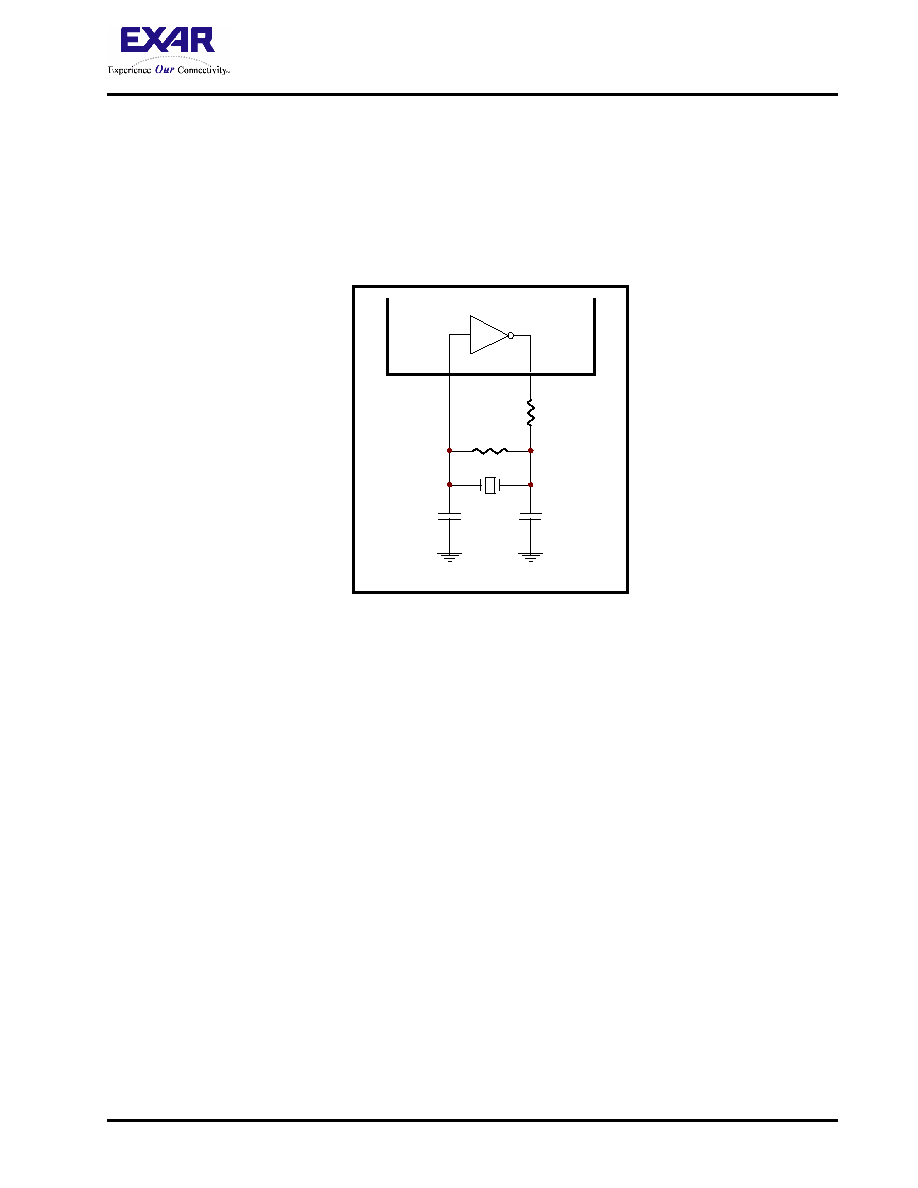- 您現(xiàn)在的位置:買(mǎi)賣(mài)IC網(wǎng) > PDF目錄16523 > XR16V2651IM-0B-EB (Exar Corporation)EVAL BOARD FOR V2651 48TQFP PDF資料下載
參數(shù)資料
| 型號(hào): | XR16V2651IM-0B-EB |
| 廠商: | Exar Corporation |
| 文件頁(yè)數(shù): | 3/51頁(yè) |
| 文件大?。?/td> | 0K |
| 描述: | EVAL BOARD FOR V2651 48TQFP |
| 標(biāo)準(zhǔn)包裝: | 1 |
| 系列: | * |
第1頁(yè)第2頁(yè)當(dāng)前第3頁(yè)第4頁(yè)第5頁(yè)第6頁(yè)第7頁(yè)第8頁(yè)第9頁(yè)第10頁(yè)第11頁(yè)第12頁(yè)第13頁(yè)第14頁(yè)第15頁(yè)第16頁(yè)第17頁(yè)第18頁(yè)第19頁(yè)第20頁(yè)第21頁(yè)第22頁(yè)第23頁(yè)第24頁(yè)第25頁(yè)第26頁(yè)第27頁(yè)第28頁(yè)第29頁(yè)第30頁(yè)第31頁(yè)第32頁(yè)第33頁(yè)第34頁(yè)第35頁(yè)第36頁(yè)第37頁(yè)第38頁(yè)第39頁(yè)第40頁(yè)第41頁(yè)第42頁(yè)第43頁(yè)第44頁(yè)第45頁(yè)第46頁(yè)第47頁(yè)第48頁(yè)第49頁(yè)第50頁(yè)第51頁(yè)

XR16V2651
11
REV. 1.0.2
HIGH PERFORMANCE DUART WITH 32-BYTE FIFO AND POWERSAVE FEATURE
2.8
Crystal Oscillator or External Clock Input
The V2651 includes an on-chip oscillator (XTAL1 and XTAL2) to produce a clock for both UART sections in the
device. The CPU data bus does not require this clock for bus operation. The crystal oscillator provides a
system clock to the Baud Rate Generators (BRG) section found in each of the UART. XTAL1 is the input to the
oscillator or external clock buffer input with XTAL2 pin being the output. For programming details, see
FIGURE 4. TYPICAL CRYSTAL CONNECTIONS
The on-chip oscillator is designed to use an industry standard microprocessor crystal (parallel resonant,
fundamental frequency with 10-22 pF capacitance load, ESR of 20-120 ohms and 100 ppm frequency
tolerance) connected externally between the XTAL1 and XTAL2 pins (see Figure 4). The programmable Baud
Rate Generator is capable of operating with a crystal oscillator frequency of up to 24 MHz. However, with an
external clock input on XTAL1 pin, it can extend its operation up to 64 MHz (16 Mbps serial data rate) at 3.3V
with an 4X sampling rate. For further reading on the oscillator circuit please see the Application Note DAN108
on the EXAR web site at http://www.exar.com.
2.9
Programmable Baud Rate Generator with Fractional Divisor
Each UART has its own Baud Rate Generator (BRG) with a prescaler for the transmitter and receiver. The
prescaler is controlled by a software bit in the MCR register. The MCR register bit-7 sets the prescaler to divide
the input crystal or external clock by 1 or 4. The output of the prescaler clocks to the BRG. The BRG further
divides this clock by a programmable divisor between 1 and (216 - 0.0625) in increments of 0.0625 (1/16) to
obtain a 16X or 8X or 4X sampling clock of the serial data rate. The sampling clock is used by the transmitter
for data bit shifting and receiver for data sampling. The BRG divisor (DLL, DLM and DLD registers) defaults to
the value of ’1’ (DLL = 0x01, DLM = 0x00 and DLD = 0x00) upon reset. Therefore, the BRG must be
programmed during initialization to the operating data rate. The DLL and DLM registers provide the integer part
of the divisor and the DLD register provides the fractional part of the dvisior. Only the four lower bits of the DLD
are implemented and they are used to select a value from 0 (for setting 0000) to 0.9375 or 15/16 (for setting
1111). Programming the Baud Rate Generator Registers DLL, DLM and DLD provides the capability for
selecting the operating data rate. Table 6 shows the standard data rates available with a 24MHz crystal or
external clock at 16X clock rate. If the pre-scaler is used (MCR bit-7 = 1), the output data rate will be 4 times
less than that shown in Table 6. At 8X sampling rate, these data rates would double and at 4X sampling rate,
they would quadruple. Also, when using 8X or 4X sampling mode, please note that the bit-time will have a jitter
C1
22-47pF
C2
22-47pF
Y1
1.8432 MHz
to
24 MHz
R1
0-120
(Optional)
R2
500K - 1M
XTAL1
XTAL2
相關(guān)PDF資料 |
PDF描述 |
|---|---|
| VE-JVN-EZ-S | CONVERTER MOD DC/DC 18.5V 25W |
| EEM28DTMN-S189 | CONN EDGECARD 56POS R/A .156 SLD |
| GSM11DRTH-S13 | CONN EDGECARD 22POS .156 EXTEND |
| A3DDH-1636G | IDC CABLE - AKR16H/AE16G/AKR16H |
| VE-JVK-EZ-S | CONVERTER MOD DC/DC 40V 25W |
相關(guān)代理商/技術(shù)參數(shù) |
參數(shù)描述 |
|---|---|
| XR16V2651IM-F | 功能描述:UART 接口集成電路 UART RoHS:否 制造商:Texas Instruments 通道數(shù)量:2 數(shù)據(jù)速率:3 Mbps 電源電壓-最大:3.6 V 電源電壓-最小:2.7 V 電源電流:20 mA 最大工作溫度:+ 85 C 最小工作溫度:- 40 C 封裝 / 箱體:LQFP-48 封裝:Reel |
| XR16V2651IMTR-F | 制造商:Exar Corporation 功能描述:UART 2-CH 32Byte FIFO 2.5V/3.3V 48-Pin TQFP T/R 制造商:Exar Corporation 功能描述:XR16V2651IMTR-F |
| XR16V2652 | 制造商:EXAR 制造商全稱(chēng):EXAR 功能描述:HIGH PERFORMANCE DUART WITH 32-BYTE FIFO |
| XR16V2652_07 | 制造商:EXAR 制造商全稱(chēng):EXAR 功能描述:HIGH PERFORMANCE DUART WITH 32-BYTE FIFO |
| XR16V2652IJ | 制造商:Rochester Electronics LLC 功能描述: 制造商:Exar Corporation 功能描述: |
發(fā)布緊急采購(gòu),3分鐘左右您將得到回復(fù)。